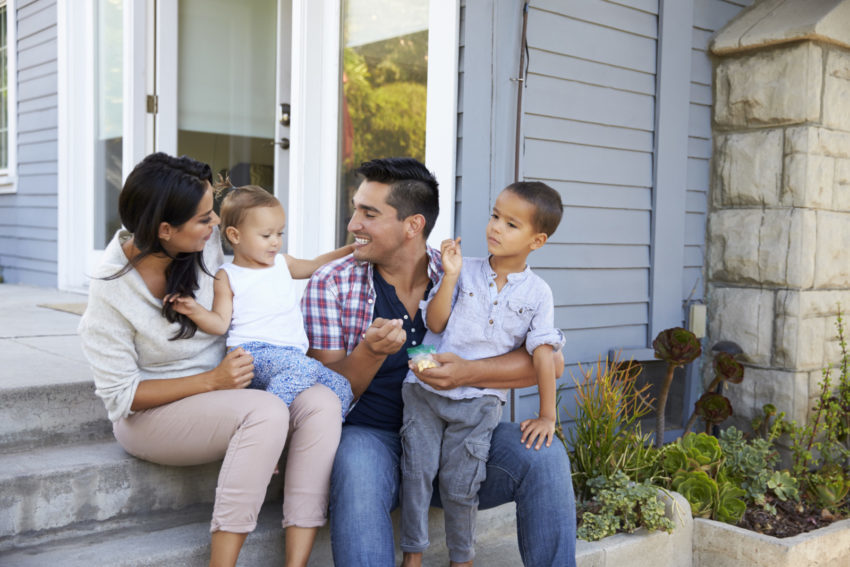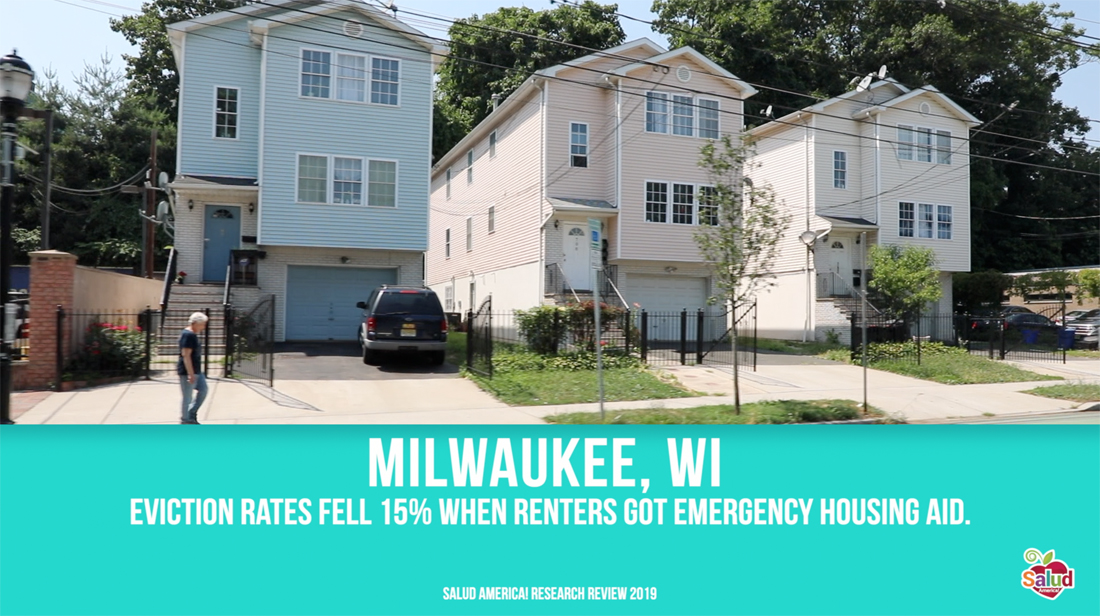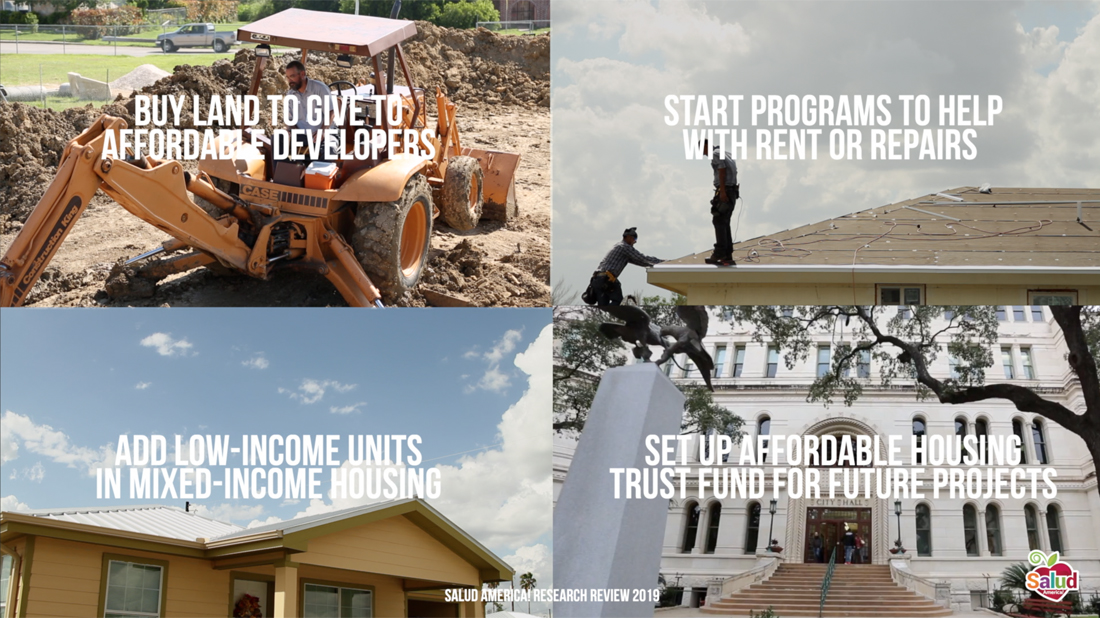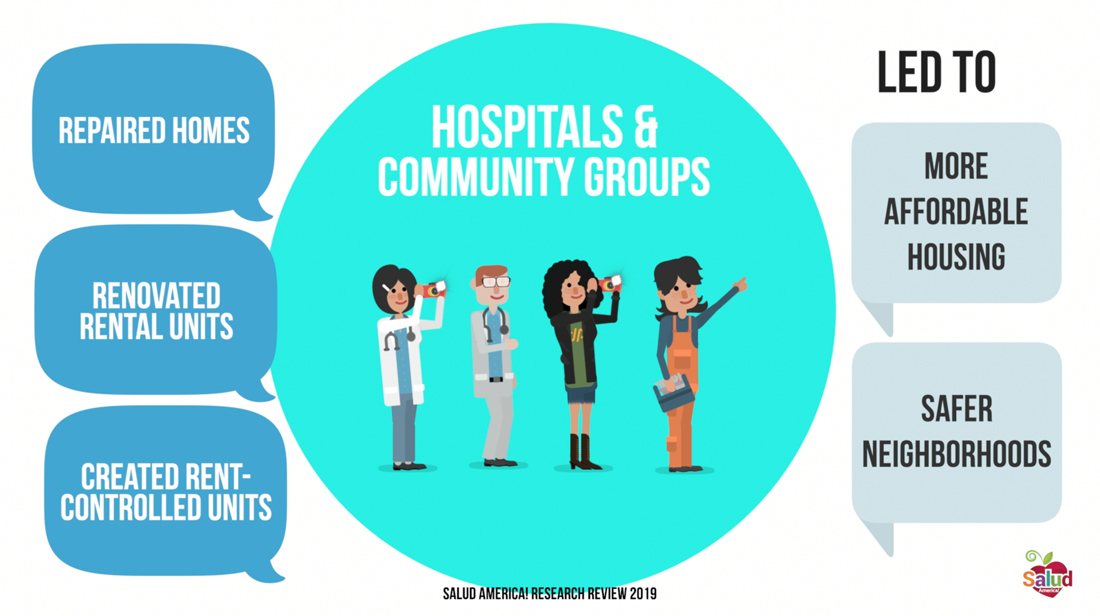
Share On Social!
This is part of the Salud America! The State of Latinos and Housing, Transportation, and Green Space: A Research Review »
Summary
Two forms of intervention could improve the current state of housing instability in Latino communities.
First, devoting more resources toward keeping renting families in their homes, and second, increasing the number of affordable housing initiatives with the ultimate goal of increasing the stock of affordable housing in Latino communities.
Keep Renters in Their Homes
Toward the first goal, development of a program that could provide aid to renters who experience drastic, but temporary, loss of income due to job loss, medical emergency, or other unexpected financial burden could prevent many forced displacements.
 In 2009, Milwaukee tenants facing eviction were given access to emergency housing aid from the American Recovery and Reinvestment Act, and the city’s formal eviction rate fell by 15% [22]. Formalization of such a program, ideally in partnership with local Latino advocacy groups that could provide assistance with paperwork and social services, would be ideal.
In 2009, Milwaukee tenants facing eviction were given access to emergency housing aid from the American Recovery and Reinvestment Act, and the city’s formal eviction rate fell by 15% [22]. Formalization of such a program, ideally in partnership with local Latino advocacy groups that could provide assistance with paperwork and social services, would be ideal.
Providing Latino tenants with public lawyers in housing court could also prevent many evictions, especially in the case of Latino families with children. While roughly 90% of landlords in housing court have attorneys, 90% of tenants lack representation due to cutbacks in legal aid to the poor [29]. Regardless of the merits of their case, tenants with legal counsel are much less likely to be evicted than those lacking representation [30, 31].
Therefore, establishing publicly funded legal services for Latino families in housing court could prevent the long-term negative consequences of eviction, decrease homelessness, and help limit discrimination in the eviction decision [22].
Increase the Stock of Affordable Housing in Latino Communities
Toward the second goal, efforts are needed to increase the number of affordable housing initiatives.
The November 2018 midterm elections are one example of how municipalities and states can meet voters’ increasing demand for affordable housing.
Initiatives were approved by voters in Texas (an affordable housing bond in Austin, a 34.5% Latino city of 950,715, according to 2017 U.S. Census population estimates), North Carolina (an affordable housing trust in Charlotte, a 13.7% Latino city of 859,035, and an affordable housing bond in Chapel Hill, a 6.2% Latino city of 59,862), Washington (extend an existing property tax for new construction of affordable housing and the preservation of existing buildings in Bellingham, a 8.3% Latino city of 89,045), and Oregon (an affordable housing bond in Portland, a 9.7% Latino city of 647,805), while voters were split in California [32].
As Latinos are seeing a larger number of their representatives coming from their own communities, they can and are leveraging this political capital to get their voices heard and their needs met [33], as these elections results suggest.
 In a more general sense, municipal, state, and federal affordable housing initiatives include [12, 32]:
In a more general sense, municipal, state, and federal affordable housing initiatives include [12, 32]:
- Strategic land purchases- municipalities buying land that they give to affordable housing developers
- Rental housing assistance programs- “low-income housing tax credits” or other subsidized rental programs
- Homes built or sold only to residents who fall under a specific income level (usually a specific percentage of the local median income)
- Mixed-income housing developments- ensure developments with any public funding set aside a proportion of units for rental to low-income residents
- Programs that pay for repairs to homes in underserved communities
- Development of an affordable housing trust to fund future projects, by providing incentives to businesses that contribute seed funds
Increasing the number of affordable housing units in some Latino communities has recently taken a new, different form. It has become clear that to bring about lasting change in disadvantaged communities, the root causes of social inequities must be addressed/. In an example outlined below, nontraditional partnerships have been established to increase the quality and number of affordable housing units in high-risk neighborhoods, in an effort to improve not only social inequity but also overall community health [5, 6].
With this approach, large neighborhood institutions such as hospitals or universities take on the role of community “sponsors” because they see the co-occurrence of clinical and social disparities, and hypothesize that addressing the social and physical environment of local residents will result in long-term, cost-effective improvements in community health and prosperity.
 The Healthy Neighborhoods, Healthy Families (HNHF) Initiative is underway in the Southern Orchards neighborhood of Columbus, OH, a low-income community with high rates of housing instability. In 2008, more than half of the households reported being home cost-burdened (>35% of income), 50% of the area’s children were living in poverty, and more than half of those children were African American and Latino [6].
The Healthy Neighborhoods, Healthy Families (HNHF) Initiative is underway in the Southern Orchards neighborhood of Columbus, OH, a low-income community with high rates of housing instability. In 2008, more than half of the households reported being home cost-burdened (>35% of income), 50% of the area’s children were living in poverty, and more than half of those children were African American and Latino [6].
Nationwide Children’s Hospital, the neighborhood medical institution, had been treating children for conditions associated with chronic stress, resulting from concentrated poverty, racial segregation, trauma, violence, low social cohesion and support, and poorly performing schools. However, because treating individual children had been ineffective and inefficient, the hospital decided, in partnership with residents, a church, and United Way, to approach the whole neighborhood as a “patient” and to treat the underlying social causes of the health conditions, starting in 2008 [6].
Because housing instability was the most obvious blight in the community, the hospital sought to improve community health by improving the state of housing in the neighborhood. In partnership with the Mayor’s office and a not-for-profit development corporation, neighborhood stabilization funds were acquired and put toward repair of currently owned homes, acquisition and repair of vacant and abandoned homes, rehabilitation of mixed-income properties, development of rent-controlled units for rental to minimum wage workers, and renovation of low-quality rental units to high-quality, low-cost rental units.
his example demonstrates that a local institution can be motivated to invest in community housing initiatives and can successfully establish nontraditional partnerships with decision-making entities including government officials and local organizations [5, 6, 34]. As housing instability greatly affects many Latinos, such an approach undertaken by large institutions in Latino communities could play a role in reducing both the social and health inequities experienced by these populations [6, 34].
Early outcomes from the Healthy Neighborhoods, Healthy Family study are beginning to emerge. Home vacancy rates have decreased from greater than 25% to less than 6%, improving safety in the neighborhood as well as real estate values. Youth who have participated in associated programs have shown progress in emotional health and academic performance, and the local high school graduation rate has increased from 64% in 2013 to 79% in 2017. Homicides have declined in Southern Orchards despite having increased in the City of Columbus [6].
While the effect of this initiative on the rental market is not yet clear, it is clear that despite improvements in neighborhood safety and health, displacement of low-income residents has not occurred, and access to high-quality affordable housing is increasing. While the long-term health data are not yet available, the hospital believes that the up-front cost of improving the social inequities affecting the community will be lower than the healthcare cost of the resultant health inequities arising from the poor housing conditions in this community.
It will be important to determine if this hypothesis is true, and if the health disparities within this community decrease as a result of the improved living conditions.
Quick links from our Research Review »
More from our Research Review »
- Executive Summary
- Introduction & Methods: Latino Housing, Transportation, and Green Space
- Research: Latino Families Burdened by Housing Costs, Eviction
- Research: Latino Rural Migration Led to Housing, Transportation Inequities
- Research: Latinos Face Big Public Transportation Challenges
- Research: Latino Communities Lack Accessible Green Space
- Strategy: How to Increase Affordable Housing in Latino Communities
- Strategy: How Transit-Oriented Development Benefit Latinos
- Strategy: Improve Public Transit to Improve Latino Quality of Life
- Strategy: Green Space Projects Can Boost Latino Health
- Strategy: Latino Community Involvement Can Spur Environmental Justice
- Policy Implications: Latino Housing, Transportation, and Green Space
- Future Research Needs: Latino Housing, Transportation, and Green Space
References for this section »
5. National Academies of Sciences, E. (2017). Communities in Action: Pathways to Health Equity. doi:10.17226/24624
6. Kelleher, K., Reece, J., & Sandel, M. (2018). The Healthy Neighborhood, Healthy Families Initiative. Pediatrics, 142(3), e20180261. doi:10.1542/peds.2018-0261
12. National Association for Latino Community Asset Builder (NALCAB). (2018). NALCAB’s Guide to Equitable Neighborhood Development. National Association for Latino Community Asset Builders. Retrieved from https://www.nalcab.org/wp-content/uploads/2018/02/NALCAB_GuideToEquitableNeighborhoodDevelopment_Final.pdf
22. Desmond. (2015). Unaffordable America: Poverty, Housing, and Eviction (pp. 1–6). Fast Focus: Institute for Research on Poverty.
29. Engler, R. (2010). Connecting Self-Representation to Civil Gideon: What Existing Data Reveal About When Counsel Is Most Needed. Fordham Urb. LJ, 37.
30. Seron, C., Frankel, M., Van Ryzin, G., & Kovath, J. (2001). The impact of legal counsel on outcomes for poor tenants in New York City’s housing court: results of a randomized experiment. Law and Society Review, 35, 419–34.
31. Greiner, D. J., Pattanayak, C. W., & Hennessy, J. (2012). The limits of unbundled legal assistance: a randomized study in a Massachusetts district court and prospects for the future. Harv. L. rev, 126.
32. Sukumaran, P. (2019, February 15). Latinos Power the U.S. Economy to a Better Future. Salud America. Retrieved March 18, 2019, from https://salud-america.org/latinos-economy-us-growth-future/
33. Carter, E. D. (2016). Environmental Justice 2.0: new Latino environmentalism in Los Angeles. Local Environment, 21(1), 3–23. doi:10.1080/13549839.2014.912622
34. Brown, A. F., Morris, D. M., Kahn, K. L., & Sankare, I. C. (2016). The Healthy Community Neighborhood Initiative: Rationale and Design, 26(1), 123–132.
Explore More:
HousingBy The Numbers
56.9
percent
of Latinos are "housing cost burdened"



